Review of the Windmill School Street: ANPR vs barriers

The barrier + steward experience
Several Headington Liveable Streets members acted as stewards for the School Street when it was manually operated with physical barriers.
During this stage there was truly a safe space around the school. Apart from a few aggressive drivers that unlawfully forced their way through, there were almost no motorised vehicles outside the school. Air pollution reduced significantly within the restricted zone. It was quiet and peaceful. It became more sociable, with children and their families more likely to chat with their friends. There was a deep feeling of sanctuary once you walked, cycled or wheeled past the barriers into the ‘safe zone’. People seemed relaxed and happy and there was a sense of community and ownership of the space.
However, this came at a price: stewards had to give up their time for over a year, carrying the signs and barriers from the school to their positions on the roads, stewarding the barriers in rain, wind and sun, regularly receiving abuse, harassment and threats from drivers who were angry about not being allowed through, even being deliberately driven at on a few occasions. Some drivers got out of their cars to move the barriers or drove on the pavements to get around them. It was shocking to find so many drivers opposed to a scheme to create a safe space for children for just 90 minutes a day.
Moving to ANPR
Because of the challenges of stewarding and difficulties finding enough volunteers (particularly once people started going back to work as covid restrictions lifted), we were all looking forward to being replaced with ANPR.
However, when the consultation launched, many of us were dismayed to see the huge list of exemptions being proposed (see the Council’s School Streets exemptions webpage for detail). Despite objections and concerns submitted, all the exemptions were implemented.
Sadly, since the School Street became enforced by ANPR rather than physical barriers:
- There are now many private cars, taxis, vans and even lorries passing through the ANPR barriers, driving past the school.
- Taxi drivers appear to be abusing their whitelisted status to use the School Street as a cut-through or to take their own children to school (the exemption is only meant to apply to taxis dropping off or collecting a fare within the School Street zone).
Moving to ANPR has essentially undermined the core purpose and aims of the School Street. The area outside the school is no longer a safe space. Before, children and their families could use the whole space to walk, cycle and scoot safely, cross the road easily and play and talk with friends; now they are confined to the pavements, with motor traffic once again dominating the space.
It’s not just Windmill School that has experienced this reduction of safety with the removal of physical barriers – it's a story repeated around the country wherever ANPR cameras take over.

Data on vehicles passing through the School Street
A Freedom of Information (FOI) request to the County Council asking how many contraventions had occurred and how many fines and warnings had been issued since implementation of the School Streets until the end of the 2022/23 academic year produced the information below:

That’s 2352 vehicles passing through the tiny restricted zone outside the school during the limited 90min closure hours (term time, weekdays, 8:20-9:00 and 14:30-15:20) in the 2022/23 academic year, creating a physical threat to children, inflicting noise and pollution, and dominating the space. And that 2352 doesn’t include the exempted vehicles that drive through, such as taxis and school staff cars.
This number seems unrealistically low compared to experience ‘on the ground’: one of us visited the School Street on 13 September 2023 between 8:29 and 8:53 and recorded around 53 vehicles passing through the School Street zone – so more than 2 vehicles per minute. We don’t know which of these vehicles are exempted and which were contravening, but whatever the case, they all contribute to making the space outside the school unsafe. An FOI response from the County Council records 38 vehicles contravening the School Street on that morning, suggesting that around 15 of the vehicles were exempted (indeed several of them were seen entering the school).
Follow-up FOI requests in respect of the 2023-2024 academic year have revealed the following:
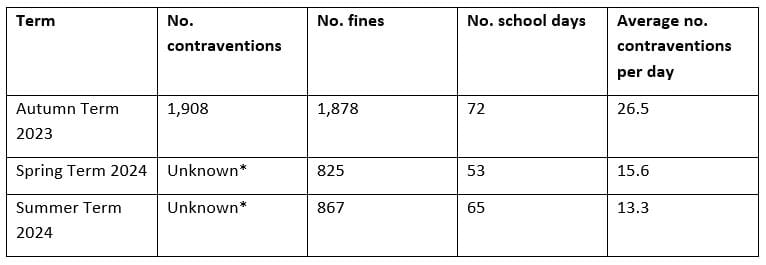
This is disappointing given how long the scheme has been in place (over a year) and we would have hoped that it had bedded-in by now – i.e. that most regular drivers at least would be aware of the restriction. It’s also important to remember that these figures don’t reflect the actual number of cars passing through the School Street, because they don’t include the exempted vehicles passing through every day.
*OCC no longer holds records of vehicles that have NOT been fined for passing through the ANPR cameras now that the 6-month warning notice period is over, including e.g. number plate misreads: only vehicles that have been captured and issued with a PCN are recorded. It’s unclear why OCC has decided to stop collecting this useful information - it seems important to know the number of drivers who contravene the Council's moving traffic restrictions without receiving a penalty, i.e. who 'get away with it' because they have fake or dirty plates or for some other reason and be able to track and demonstrate the effectiveness of its enforcement.
Who is driving through the School Street?
Most of the vehicles seem to come from the Ring Road via Headington Quarry, with a smaller number coming from London Road via Wharton Road. Most of them drive straight through past the school, with a smaller number turning into York Road. In the mornings, the closure point at Wharton Road sees the most cars coming through.
The categories of drivers driving through the School Street include:
- Drivers without a permit/exemption who accidentally drive through, not knowing about the restriction or noticing the signs.
- Drivers without a permit/exemption who deliberately drive through, e.g. with obscured or false plates, who know they are untraceable via DVLA or who are willing to pay a fine.
- School staff with exemptions.
- Taxi drivers.
- Council vehicles including vans and lorries (which may have an exemption).
- Blanchfords lorries (it’s not clear whether they have an exemption).
- Any other drivers with exemptions/permits.
This is the breakdown of permits for the Windmill School Street as provided by the Council in response to an FOI request:
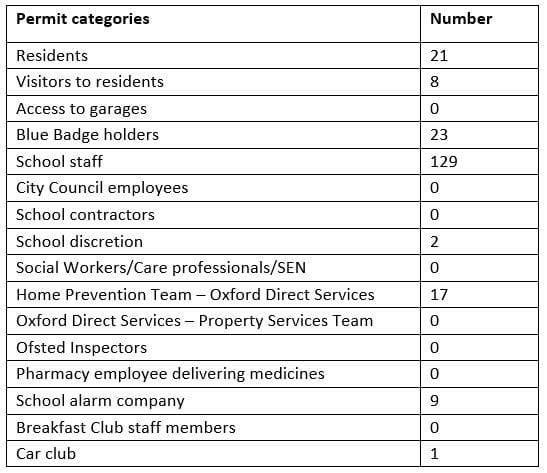
On top of these permits, there are automatic exemptions for all 1040 taxis licensed by Oxford City Council and all branded/liveried delivery vans registered as commercial vehicles such as Royal Mail, UPS and DPD.
School staff exemptions
At 129, the large number of school staff exemptions feels particularly disappointing: this is more than the number of permanent staff at the school, and suggests that school staff may not support the aims of the School Street.
Interestingly, the Council’s webpage cites this exception as “School staff and regular school visitors with a requirement to park onsite”. It’s not clear whether “requirement” = “need” in this case or just “want”.
During the public consultation it was suggested to the relevant officer at the County Council that the Council should use its discretion when granting permits to this category or indeed establish a formal policy to only grant them to people who can demonstrate a genuine need to use a car to travel to work at school in the first place. The Council could have implemented a parking permit scheme along similar lines to those in place for OUH NHS Trust, Oxford Brookes University and Oxford University. This would have helped lay the ground for the workplace parking levy when it comes in.
However, the Council’s response to an FOI request asking “Could you please also confirm whether the Council applies any criteria when considering applications from school staff to determine whether there is an objective need for staff to drive to school and park in the school car park (e.g., no viable active travel or public transport alternatives)” was:
“Oxfordshire County Council (OCC) does not hold this information. Currently, it is at the school’s discretion to determine who receives a staff permit.”
This is disappointing on behalf of both the Council and the school, and a missed opportunity to bring about much-needed behavioural change.
There are staff who regularly drive to the school when they could easily make those journeys without a car. The difference between the generous, free, unrestricted parking available to school staff in Headington and the restricted, needs-based parking for hospital and university staff is stark and difficult to justify. However, in light of the global warming, public health damage and road danger caused by cars, it is the hospitals and universities who are getting this right.
School discretion to grant exemptions
Some people involved in School Streets schemes are critical of how schools are put in the uncomfortable position of deciding which staff and parents get exemptions, as this causes conflict and puts an unfair strain on the resources and goodwill of the school management.
Schools understandably find it difficult to say “no” to parents and staff who ask for a permit, resulting in a high number of discretionary exemptions. It is likely that this discretion for schools has limited the modal shift potential of the schemes due to the relative ease of obtaining an exemption instead of changing transport behaviour.
This task could arguably be managed more effectively by Council officers according to a well-defined set of objective criteria similar to those of OUH, Oxford Brookes and Oxford University.
Exempted vehicles not recorded
Various FOI responses have revealed that “Oxfordshire County Council does not hold [the number of exempted vehicles that have passed through the School Street]. All exempt vehicles are entered onto a whitelist in the bespoke Automatic Number Plate Recognition (ANPR) system and therefore are not captured if they drive through one of the ANPR locations. We do not hold a record of vehicles that have NOT been fined for passing through the ANPR cameras, only vehicles that have been captured are recorded.” The same applies to the ANPR cameras in the Cowley and East Oxford LTNs.
This means that the Council can’t use the ANPR cameras to monitor how many, and which, exempted vehicles are driving through the School Streets, Cowley LTN bus gates or the LTN ANPR filters, and there is no accurate record of the true volume of vehicles passing through the School Streets and LTNs that use ANPR cameras.
Taxi drivers
Taxi drivers have been observed on multiple occasions breaching the School Streets TRO by driving through to take their own children to school or use it as a through route. (The taxi exemption in the TRO only applies to taxis collecting or dropping off a fare within the restricted zone.)
As mentioned directly above, none of these taxi journeys are recorded by the ANPR system. And even if they were, there is no dataset of fare-carrying taxi journeys available from the taxi companies with which to compare them. This shows that:
- taxi drivers can and do abuse their exempted status;
- ANPR is ineffective in monitoring or enforcing taxi drivers’ (and other exempted drivers’) use of ANPR-enforced filter points; and
- ANPR closure points enable taxi drivers to use School Streets and ANPR-enforced LTNs for personal benefit, e.g. taking their own children to/from school, shopping by car, driving to social or leisure activities.
Lax enforcement
FOI responses from the County Council refer to:
- A 6-month initial “legislative period” based on current statutory guidance in which only warnings are issued for first time offences at each camera location, meaning 6 months of weakly enforced illegal driving through the School Streets.
- Reference to a ‘locally implemented rule’ whereby drivers receive 3 warning notices in a 2-week period and are only issued with a PCN following the 2-week period.
- DVLA having no trace for the vehicle owners of some of the cars that have illegally driven through the School Streets, meaning that such drivers cannot be issued warnings or fines and can presumably drive through the School Streets as much as they like.
The Council has confirmed that the first two rules will apply to ANPR to be used in the Cowley and East Oxford LTNs. This will therefore presumably apply to all future camera-controlled LTN closure points.
Danger increased at junction
An unintended side effect of the School Streets closure point on Margaret Road near Wharton Road is that it has made the Wharton Road/Margaret Road junction even more dangerous as more drivers are turning right into it to avoid the closure point. This will be the case whether there is a physical barrier or ANPR cameras.
There have been many, many close-miss incidents on the crossing, often involving drivers reversing into children walking, scooting, cycling or in pushchairs as they illegally park near the junction or make way for other cars using the junction. A typical cause is drivers trying to turn left onto Margaret Road from Wharton Road, realising they can’t due to a stream of cars coming from the Quarry, so reverse back into the road entrance where families are crossing to get to school.
Surrounding roads are still dangerous – there are still no safe routes to school
Although School Streets are a fantastic measure, even when they work effectively, they only protect a very small area of road directly outside the school.
The roads outside of the closure points are no safer than before: they still carry traffic that diverts around the closure points and parents who drive still park illegally and dangerously and idle their engines.
For example, the lorries in the photos below were driving down Margaret Road during School Street operational hours when young children were cycling to school there. This is the route to school for most families coming from the west side of the catchment area.
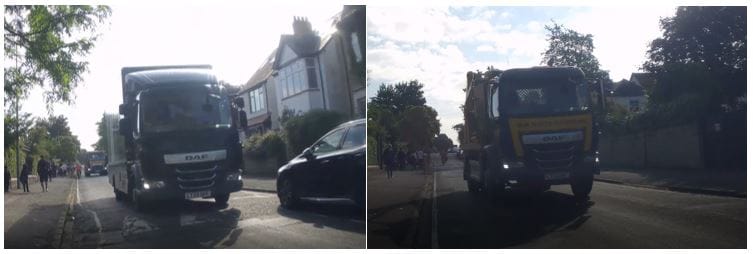
So, although School Streets provide a refuge immediately outside the school, they do nothing to make the rest of children’s routes to school by walking or cycling safer.
The Headington LTNs would have made the School Street more effective
The main source of the problematic vehicle movements that cause danger to children, both by driving through the restricted zone and turning in or out of the Wharton Road junction are drivers using Headington Quarry as a rat-run. Most seem to come from the Ring Road, through Headington Quarry, down Margaret Road and then either drive through the closure point near Wharton Road or turn right into Wharton Road to avoid it. However, people do drive through from all directions.
If the Headington Quarry LTN had been implemented, this would have removed all through-traffic from Margaret Road and the surrounding roads. It would have prevented drivers from rat-running from the Ring Road through Quarry into Headington. It would have made the narrow roads in Quarry safe for children to walk and cycle along.
The map below shows where the filter points were going to be positioned (the blue dots) to stop through traffic using these roads according to the Council’s 2021 plans:
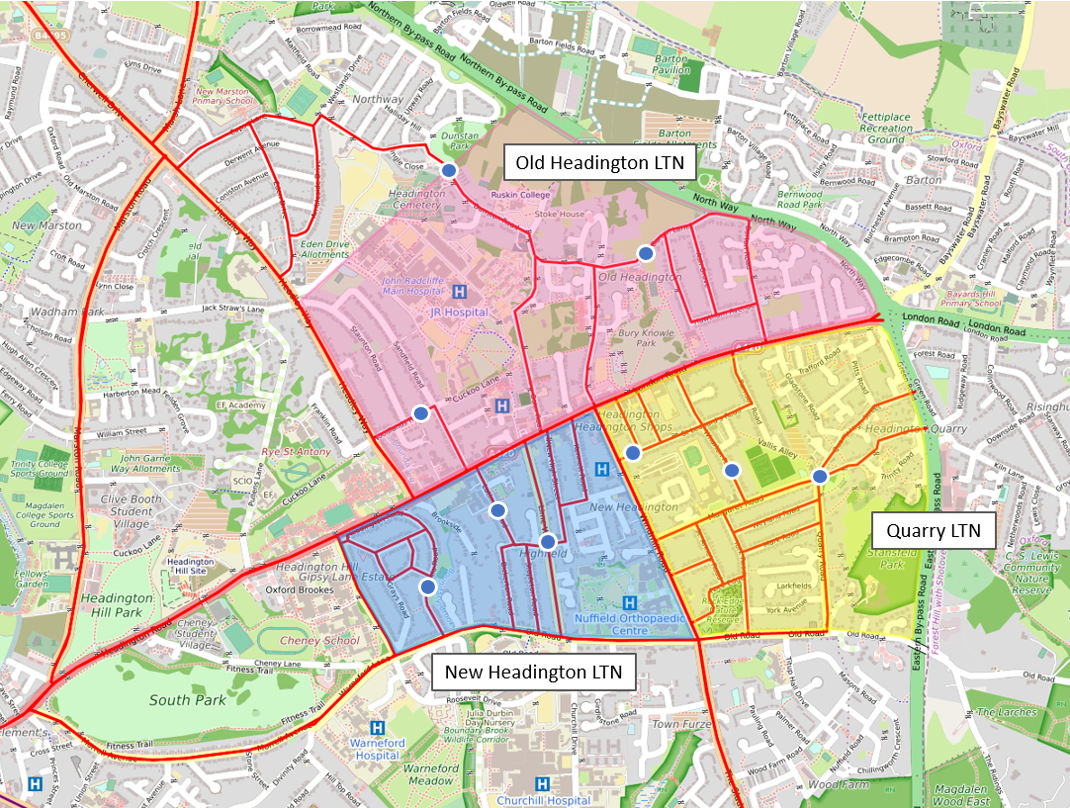
The filter at the junction of Quarry High Street and Quarry Hollow would have prevented drivers from rat-running from the Ring Road and down Margaret Road. It would also have allowed a ‘place-making’ opportunity at the junction and a safe, easy crossing between the two parks. The visualisation below gives an idea of what could be done with the space if this junction was closed to through-motor traffic as proposed in the 2021 plans.
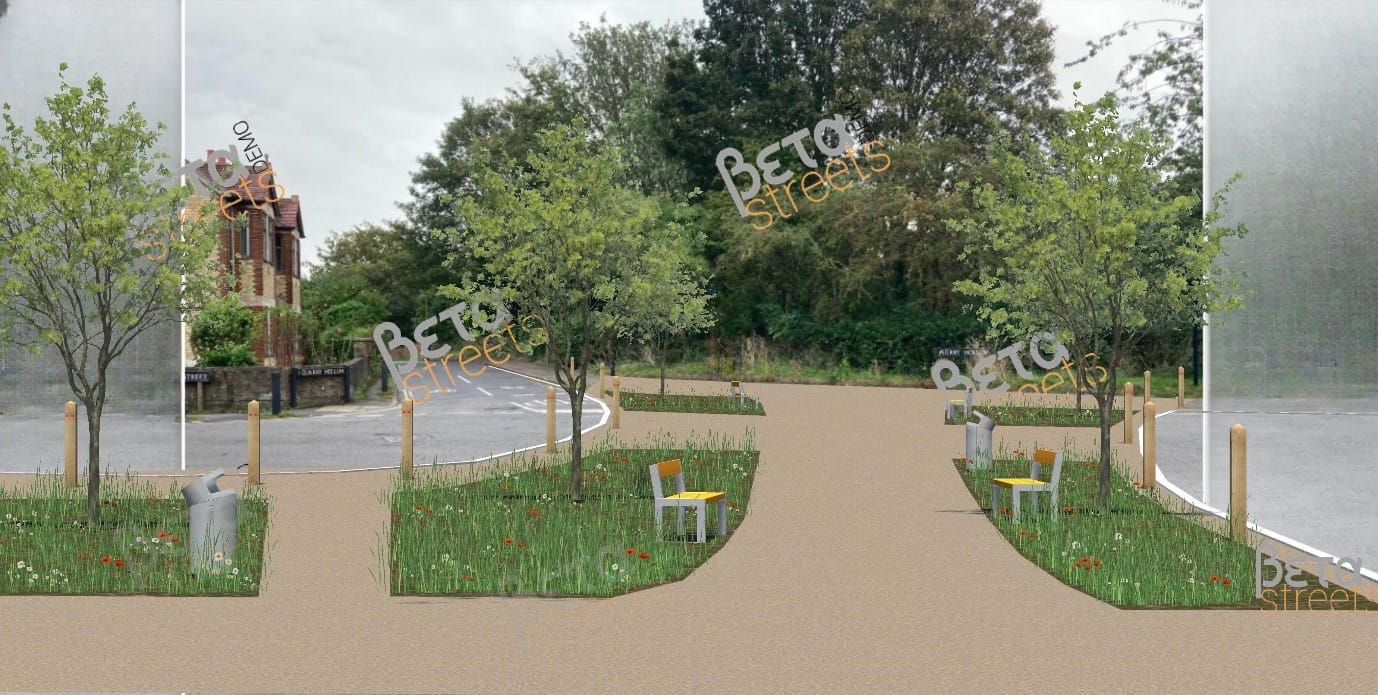
The filter on Wharton Road would have prevented drivers from rat-running from London Road to Windmill Road using Wharton Road and Margaret Road. This would in turn make the Wharton Road/Margaret Road junction much safer. The visualisation below gives an idea of what could be done with the space if the filter on Wharton Road had been implemented.
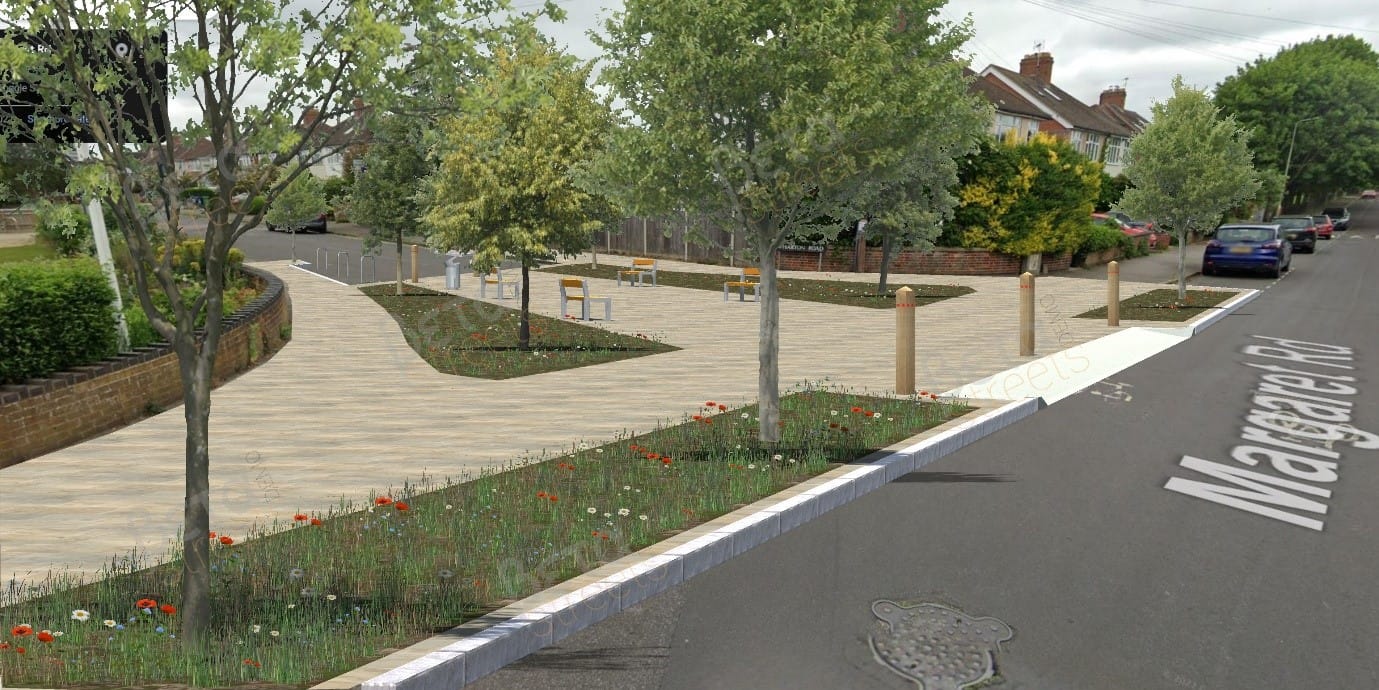
The School Street would be much safer as there would be no cut-through traffic and significantly less traffic generally. For example, the two lorries in the above photos would almost certainly not have been travelling through those roads.
Almost every other school in Oxford is in a low traffic neighbourhood, with safe walking and cycling routes to school enabled by quiet roads in surrounding LTNs. Headington is an outlier in the city in not having LTNs which children can use to walk, scoot or cycle to school safely.
See map below for detail (remaining high-traffic neighbourhoods and roads shown in red):
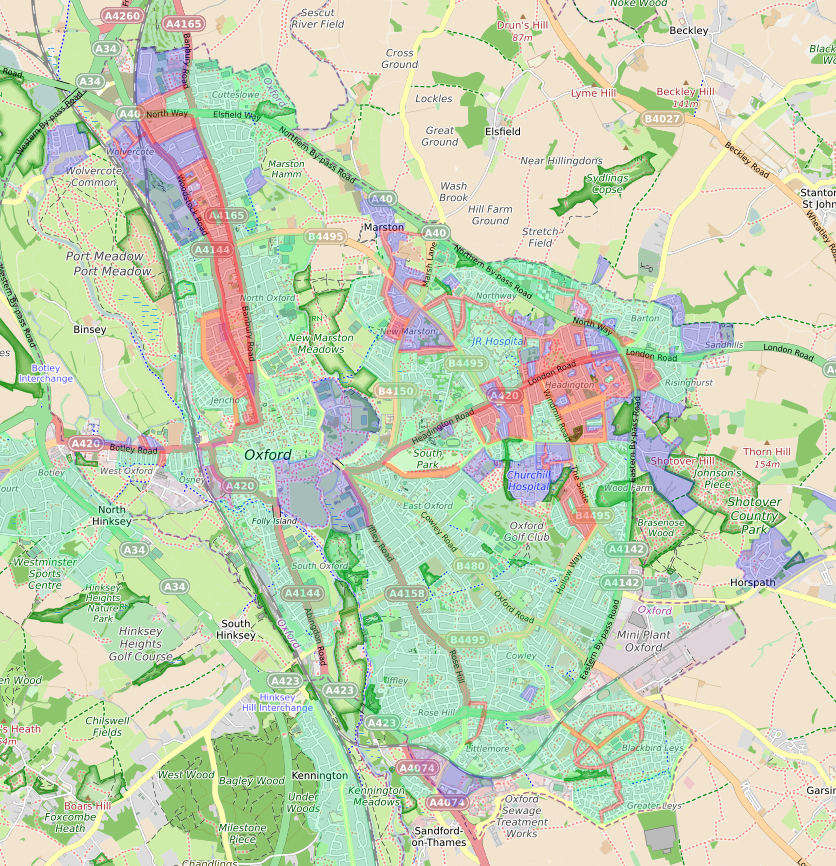
Perhaps notably, every other school that has a permanent or trial School Street is situated in an LTN:
- St Nicolas Primary School, Abingdon
- Larkrise Primary School, Iffley
- St Ebbe’s Primary School, Grandpont
- Manor Primary School, Didcot
- New Hinksey CE Primary School, Grandpont
- St Mary and St John CE Primary School, Iffley Fields
- Sandhills Community Primary School, Sandhills
- Tyndale Community School, Temple Cowley
Whereas Windmill Primary School is on a major rat-run from the Ring Road through to Windmill Road/Old Road, which is reflected in the significantly higher contravention figures for Windmill compared to the other schools.
Our verdict
Although we are incredibly grateful to the Council for rolling out the School Streets schemes in Oxford and fully support them, in particular the Windmill School Street, there is much room for improvement with the Windmill scheme. The current operation of the scheme is failing to deliver its full potential for children and their families, with compromised safety within the School Street zone and no improvement in safe active travel routes to the school.
Our key points regarding the Windmill School Street:
- It’s probably better than having nothing at all, although it’s arguable that safety is more compromised in a space where children have an expectation of no cars – it’s a confusing message to tell them: “this is a safe space for children”, only for them to find numerous motor vehicles driving in that “safe space”.
- It’s nowhere near as safe with ANPR cameras as it was with barriers and stewards.
- With ANPR instead of barriers, many drivers aren’t even aware there is a School Street restriction.
- The ANPR cameras don’t record or prevent illegal driving of exempted vehicles, leaving the scheme open to abuse by drivers of whitelisted vehicles.
- The generous, unconditional exemptions for school staff provide no incentive for them to use non-car methods to travel to work and support the School Street.
- A higher level of modal shift could be achieved if discretion in granting exemptions was removed from schools and instead managed by Council officers according to a well-defined set of criteria based on an objective and demonstrable need to drive.
- The School Street would work much better with the Quarry LTN in place, which would put Windmill Primary School (and St Andrew’s Primary School and Headington Quarry Foundation Stage School) on an equal footing with nearly every other school in Oxford by being situated in, and accessible via, a low-traffic neighbourhood.
- The School Street could be much improved with permanent physical barriers.
Our lack of ambition with School Streets in Oxford and the UK generally is clear when compared with School Streets in Paris, where streets are permanently protected with gates and gardens and play areas are created – see this Streetfilms video which showcases what is possible if the necessary political will and pro-social public opinion exists to prioritise children’s safety and wellbeing above adults’ driving convenience: Paris School Streets: Safe for Children, Safe for Everyone.
